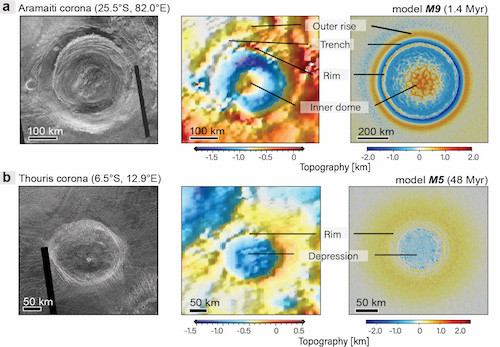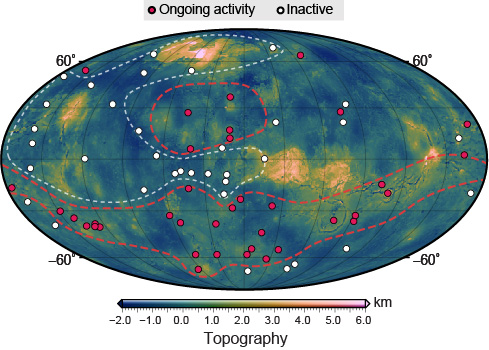Widespread ongoing plume activity on Venus revealed by variations in the morphology of large coronae
- 1Institute of Geophysics, Department of Earth Sciences, ETH Zürich, Zürich, Switzerland (anna.guelcher@erdw.ethz.ch)
- 2Department of Geology, University of Maryland, College Park, USA
In the absence of global plate tectonics, mantle convection and plume-lithosphere interaction are the main drivers of surface deformation on Venus. Whether Venus is geologically active today remains in question: the apparent young surface age and random distribution of impact craters on the planet, initially ascribed as resulting from a global resurfacing event 500-700 Myr ago1,2,3, can also be explained by equilibrium processes, suggestive of ongoing regional resurfacing4,5. Moreover, recent studies have identified active hotspots6,7,8,9 and young individual lava flows10 on the planet.
Among documented tectonic structures, circular volcano-tectonic features known as coronae are perhaps the clearest surface manifestations of mantle plumes and may hold clues to the global Venusian tectonic regime. Coronae are characteristic quasi-circular volcano-tectonic features that are abundant on the Venusian surface and generally associated with volcanism, topographic relief, and concentric or radial faulted patterns9,11,12 (left panels of Fig. 1). They feature a wide range of sizes and morphology but typically display an annulus of closely spaced concentric fractures and/or ridges superimposed on a raised rim, with a central relief ranging from domes to depressions12. The exact processes underlying their development and the reasons for their diverse morphologies remain controversial.
We conducted a systematic 3D numerical study of plume-lithosphere interaction that links the morphological diversity of large coronae to lithospheric structure and provide guidance for identifying which coronae are currently active. The morphology of at least thirty-seven coronae, dominantly located in a region covering Themis Regio, Lada Terra, and Alpha Regio, is consistent with present-day activity. We thereby provide evidence for widespread plume activity on the planet. The work presented here has just been published in Nature Geoscience13. 
Fig 1. Venusian coronae (left), their topographic signatures (middle) and comparison with numerical models (right)13
3D numerical experiments of coronae formation
We ran 3D high-resolution thermomechanical numerical simulations of impingement of a thermal mantle plume into the Venusian lithosphere to assess the origin and diversity of large Venusian coronae. We systematically varied plume size and temperature, the lithospheric strength and crustal thickness in the models. Our results reveal four regimes of plume-lithosphere interactions underlying corona development at the surface (Figure 2): (1) lithospheric dripping, (2) short-lived subduction, (3) embedded plume, and (4) plume underplating. The ratio of plume buoyancy over lithospheric strength majorly controls these dynamic regimes. This found dependency of plume-lithosphere dynamics on plume buoyancy and lithospheric configuration is key for future studies on plume-lithosphere interactions on Venus or (early) Earth.
During the first three plume-lithosphere interaction scenarios (regimes (1)-(3)), plume penetration and spreading induce crustal thickness variations that eventually lead to a final topographic isostasy-driven topographic inversion that turns circular trenches surrounding elevated interiors into raised rims surrounding inner depressions.
Reasons behind the morphological diversity of coronae
The temporal evolution of the topographic profiles of the modelled coronae show that different corona morphologies represent not only different styles of plume-lithosphere interactions, but also different stages in evolution. Coronae with rims and/or trenches are only produced by mantle plumes that (partially) penetrate into the Venusian lithosphere. The common occurrence of coronae displaying rims on Venus suggests that most plumes that formed coronae were able to penetrate at least partially into the lithosphere. In addition, for coronae formed by a penetrative mantle plume, we are able to distinguish active from inactive structures: active coronae feature an outer trench and rise that imply ongoing suction above downwards-moving lithospheric material, as well as elevated interior supported by plume buoyancy. By contrast, inactive coronae show an inverted topographic profile with an outer rim and an inner depression linked to a thinned lithosphere.
Observational evidence for coronae activity and implications for Venus' geodynamics
We evaluated the possibility of present-day corona activity by systematically analysing the surface topography of large coronae on Venus. Each corona is labelled as currently “active” if it features a clear outer rise and trench, “inactive” if no outer rise but a rim and inner depression is evident, or“unclassified” if the presence of these features is ambiguous. We found expressions of current activity on thirty-seven coronae on Venus (including Artemis Corona, Fig. 1a), whereas thirty-five other coronae were marked “inactive” (including Thouris Corona, Fig. 1b). The remaining coronae are marked “inconclusive”, either because their topography was not well resolved by the dataset, presented ambiguous features, or was markedly different from that obtained in our models. 
Fig 2. Global distribution of coronae identified as inactive (white circles) or showing ongoing plume activity (red circles)13
Our study presents new evidence for recent tectonic and magmatic activity in the lithosphere Venus, complementing other indications of such activity6,8,10,15,16. Coronae activity spanning a variety of surface ages implies a gradual resurfacing behavior of Venus, akin to Earth-like volcanic and interior processes4,5. Moreover, the global arrangement of active coronae (Fig. 2) suggests a large-scale organization of tectono-magmatic activity on the planet, with a broad active region covering Themis Regio, Lada terra, and Alpha Regio, as well as Eistla Regio, in contrast to regions where large active coronae are absent (around Beta and Phoebe Regiones). Finally, our suggested regions of extensive recent corona activity may serve as interesting targets for detailed investigation by future spacecraft missions.
References
1. Turcotte, D.L. (1993) J. Geophys. Res. 98, 17061-17068
2. Strom, R.G. et al. (1994) J. Geophys. Res. 99, 10899-10926
3. Romeo, L. (2013) Planetary and Space Science 87, 157-172
4. Herrick, R.R., & Rumpf, M. E. (2011) J. Geophys. Res. 116, E2
5. Bjonnes, E.E. et al. (2012) Icarus 217, 451-461
6. Smrekar, S.E. et al. (2010) Science 30, 605-608
7. Phillips, R.J. et al. (1991) Science 252, 651-658
8. Stofan, E.R. et al. (1995) J. Geophys. Res. 100, 23317-23327
9. Stofan, E.R. et al. (1992) J. Geophys. Res. 97, 13347-13378
10. Filiberto J. et al. (2020) Science Adv. 6, eaax7445
11. Stofan, E.R. et al. (1991) J. Geophys. Res. 96, 20933-20946
12. Roberts, K. and Head, J. W. (1993) Geophys. Res. Let. 20, 1111-1114
13. Gülcher, A.J.P. et al. (2020) Nat. Geosci., https://doi.org/10.1038/s41561-020-0606-1
14. Gerya, T.V. (2014) Earth Planet. Sci. Lett. 391, 183-192
15. Sandwell, D.T., & Schubert, G. (1992) Science 5071, 766-770
16. Zampa, L.S. et al. (2018) Planetary and Space Science 157, 48-62
How to cite: Gülcher, A., Gerya, T., Montési, L., and Munch, J.: Widespread ongoing plume activity on Venus revealed by variations in the morphology of large coronae, Europlanet Science Congress 2020, online, 21 September–9 Oct 2020, EPSC2020-52, https://doi.org/10.5194/epsc2020-52, 2020

